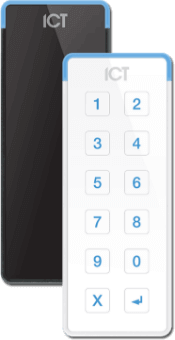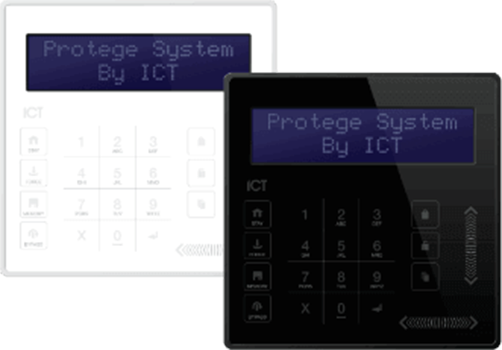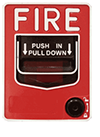Video MGMT System
 Access Control
Access Control
Voice & Data Wiring
 Burglar Alarm
Burglar Alarm
 Fire Alarm
Fire Alarm
Video MGMT System
Voice & Data Wiring
THOUGHT CENTER > Blog > Access Controls
October 12, 2023
Too busy to read? Here’s a summary:
Whether you need a quick tap-and-go payment at your local grocery store or to gain access to an office or building, you can use the very same smart card for a seamless user experience. Smart cards can process data, carry out commands, and secure information thanks to recent advancements in circuit chip technology.
In this comprehensive guide, we’ll dive into different types of smart cards for access control, their functionalities, and their uses in different industries.
At their core, smart cards are designed to securely store data, process information, and give and respond to commands.
Smart cards are highly encrypted and contain significantly more memory than regular access control cards, allowing a single smart card to securely serve multiple functions—including access control, cashless payment, and information storage.
In some countries, smart cards are even used to access public services. For example, a single smart card in China may be used to prove eligibility for government benefits, borrow library books, and pay for public transportation services.
When used as credentials for access control, smart cards transmit verifying data contained on their circuit chips to credential readers at access points. The data is then authenticated and cross-checked against site access authorizations.
If there’s a match between the smart card data and preprogrammed permissions at the entry point where the card is presented, doors unlock electronically to grant passage.
Smart cards use integrated circuits that can be contact-based (requiring a physical connection with a reader), contactless (using electronic signal technology to communicate with a reader), or a combination. The most advanced type of smart card is a microprocessor card.
Contact smart cards, as their name suggests, involve physical interaction with the card reader.
When inserted into a reader, these cards facilitate data exchange and execute applications via a small gold chip on their front.
This direct contact provides robust security, making contact smart cards an ideal option for situations where sensitive information or spaces are involved.
Whether it's credit cards, SIM cards, or secure access control to buildings, contact cards are a highly secure option for data transmission.
Contactless smart cards add convenience to the security equation because they don’t require direct physical interaction with an access control reader.
Instead, these cards employ Radio Frequency Identification (RFID) or Near-Field Communication (NFC) technology to communicate with readers when they are within range.
Hybrid smart cards offer the functionalities of both contact and contactless smart cards.
They come equipped with two separate chips, each catering to contact or contactless functionalities.
Like hybrid cards, combi cards offer both contact and contactless functionalities, but with a twist: they contain a single chip that can transmit data with or without physical contact with a reader.
Microprocessor cards take the functionality of smart cards up a notch.
These power-packed cards, much like miniature computers, are equipped with an operating system, file management capabilities, and even the power to execute applications.
They offer heightened security and significant data storage space, making them the go-to solution for sophisticated access control systems.
Smart cards use advanced encryption and authentication protocols that make it difficult for unauthorized individuals to access sensitive information and controlled areas.
In hospitals and other medical facilities, access to restricted areas like pediatric units and drug storage rooms is securely controlled and managed with smart card technology.
What’s more, smart cards can store patient information, such as medical histories. This data is used to improve efficiency by granting authorized professionals instant access to patient information.
Healthcare/HIPPA Compliance: It’s important to set up secure protocols for access to smart card data when it includes private patient information. Consult with security or IT professionals who are familiar with HIPAA and local regulations in order to ensure that patient privacy is protected and that your organization is compliant with regulations.
Smart cards can be part of multi-factor authentication systems, requiring the card in combination with a PIN, biometric data, or other verification methods before the system will grant access.
In government agencies, multi-factor authentication provides a necessary added layer of protection for high-security areas and sensitive data.
Smart cards are easily programmable and adaptable to a wide range of access control needs. For example, they can be programmed to allow access to different areas based on a cardholder's individual ID, job role, or even the time of day.
In a large school district, smart cards can be programmed to allow teachers access to their specific classrooms and the staff lounge, while janitors may be granted access to supply rooms and all classrooms.
College students often receive smart cards for access to library privileges, communal areas, dorm rooms, and the specific classes they’ve signed up for.
Smart card systems create an audit trail, documenting who accessed a particular area and when. This can be crucial for investigating incidents, as well as understanding user behavior generally.
On manufacturing sites, smart cards can provide detailed logs of when workers enter and leave. This helps administrators to manage worker hours, monitor compliance with safety regulations, and investigate incidents that occur on-site.
Smart cards for access control can be integrated with other systems, such as those for payroll, time and attendance, and computer logins.
In an office building or apartment complex, access control smart cards can be used for logging into computers, viewing resources, and making payments at cafeterias or laundry facilities.
Choosing the right credentials for an access control system can be a daunting task. Each type of smart card offers unique features and compatibilities. For help assessing the credential technology that best aligns with your specific access management needs, reach out to the team at Mammoth Security.
We know the ins and outs of modern security systems, including systems for access control, CCTV surveillance, intrusion detection, fire safety, and structured cabling for voice and data transmission. For a free site survey and security consultation with a friendly member of our team, just fill out the simple form below.
NOT COMPLETELY SURE?
860-748-4292The different types of smart cards for access control include contact smart cards, contactless smart cards, hybrid smart cards, combi cards, and microprocessor cards.
Smart cards interact with credential readers through direct contact (inserting the card into the reader) or contactless signal technologies like RFID and NFC.
Smart cards for access control offer numerous advantages, including enhanced security, convenience for users and administrators, and scalability. Smart cards can store large amounts of data, execute applications, and are encrypted for added security.
Like any technology, smart cards are not immune to hacking. However, their advanced encryption and authentication features make them significantly more secure than standard access cards.
Factors to consider when choosing a smart card for an access control system include the level of security required at the site they will protect, the need for contact or contactless interaction, memory requirements, and your budget.